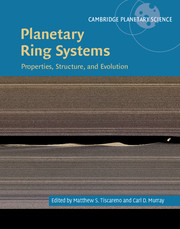Book contents
- Frontmatter
- Contents
- List of Contributors
- Acknowledgements
- I Introductory Material
- II Ring Systems by Location
- III Ring Systems by Type and Topic
- 8 Moonlets in Dense Planetary Rings
- 9 Meteoroid Bombardment and Ballistic Transport in Planetary Rings
- 10 Theory of Narrow Rings and Sharp Edges
- 11 Narrow Rings, Gaps, and Sharp Edges
- 12 Dusty Rings
- 13 The F Ring of Saturn
- 14 Plasma, Neutral Atmosphere, and Energetic Radiation Environments of Planetary Rings
- 15 Thermal Properties of Rings and Ring Particles
- 16 Computer Simulations of Planetary Rings
- 17 Laboratory Studies of Planetary Ring Systems
- 18 The Origin of Planetary Ring Systems
- IV Concluding Material
- Index
- Plate section
- References
12 - Dusty Rings
from III - Ring Systems by Type and Topic
Published online by Cambridge University Press: 26 February 2018
- Frontmatter
- Contents
- List of Contributors
- Acknowledgements
- I Introductory Material
- II Ring Systems by Location
- III Ring Systems by Type and Topic
- 8 Moonlets in Dense Planetary Rings
- 9 Meteoroid Bombardment and Ballistic Transport in Planetary Rings
- 10 Theory of Narrow Rings and Sharp Edges
- 11 Narrow Rings, Gaps, and Sharp Edges
- 12 Dusty Rings
- 13 The F Ring of Saturn
- 14 Plasma, Neutral Atmosphere, and Energetic Radiation Environments of Planetary Rings
- 15 Thermal Properties of Rings and Ring Particles
- 16 Computer Simulations of Planetary Rings
- 17 Laboratory Studies of Planetary Ring Systems
- 18 The Origin of Planetary Ring Systems
- IV Concluding Material
- Index
- Plate section
- References
Summary
All of the giant planets in the outer Solar System possess rings composed primarily of particles less than 100 microns across. Such small particles are conventionally referred to as “dust grains” regardless of their composition, and so these rings are considered “dusty rings” (as opposed to the more famous main rings of Saturn and Uranus, whose particles are more than a millimeter across). Dusty rings are often very tenuous and so can be much more difficult to observe than Saturn's broad, bright, and dense main rings. Nevertheless, dusty rings are extremely interesting because they have very rich dynamics and are extremely sensitive probes of their environment.
The high surface-area-to-volume ratio of dust-sized grains makes them much more responsive to non-gravitational forces like solar radiation pressure, plasma drag, and torques from the planet's electromagnetic field. Furthermore, sub-millimeter particles can be lost from the ring system on relatively short timescales due to erosion via charged-particle and micrometeoroid bombardment or through ejection by the non-gravitational forces listed above. This means that small particles need to be constantly supplied to these rings from larger bodies, and indeed all of the known dusty rings are associated with larger objects that are the likely sources of dusty debris. The most dramatic example of this is Saturn's E ring, which is clearly supplied by material erupting from beneath the surface of the geologically active moon Enceladus. However, this is a special case, and most dusty rings are instead associated with denser rings (which are composed primarily of millimeter-to-metersized particles) or small moons. These objects can serve as dust sources because they are constantly being bombarded by micrometeoroids, and these impacts release fine debris that can escape the weak gravitational fields of these small bodies and go into orbit around the planet. Note that the amount of dust released by this process depends on the size, mass, and regolith properties of the source object, and calculations of the dust production rate based on simple estimates of impact ejecta velocity distributions suggest that source moons that are several kilometers across are the most efficient at producing dusty rings (Burns et al., 1999).
Information
- Type
- Chapter
- Information
- Planetary Ring SystemsProperties, Structure, and Evolution, pp. 308 - 337Publisher: Cambridge University PressPrint publication year: 2018
References
Accessibility standard: Unknown
Why this information is here
This section outlines the accessibility features of this content - including support for screen readers, full keyboard navigation and high-contrast display options. This may not be relevant for you.Accessibility Information
- 9
- Cited by
